This heritage story begins in Auburn, Cayuga County, New York, a small industrial city in the Finger Lakes.
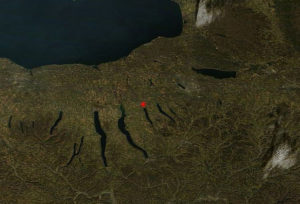
Source: earthdata.nasa.gov/labs/worldview
Auburn was built on the power of the Owasco River, flowing from Owasco Lake north to the Seneca River. Like most of the cities, towns, and counties of Central New York and the Eastern Finger Lakes, it was drawn up from various “Great Lots” of the then “New” Military Tract. New York State used the 1788 Treaty at Fort Schuyler to extract this land from the Haudenosaunee people, but all subsequent treaties between US states and Indian nations became illegal when the United States Congress passed the “Trade and Intercourse Act” two years later.
The Great Lot lines show up on modern maps from time to time.

Two examples of 20th century survey notes referencing Great Lot 47.
I live in the Great Lot 47 of Township number 8, Aurelius.
Auburn is “History’s Home Town,” and lucky for me there are many passionate historians and map collectors in our community. When I first moved here about twenty years ago, my cousin’s husband listed all the historic places I should go and see.
My cousin-in-law was an intrepid and passionate student of local history. He loved Finger Lake artists, he collected fossils, and was kind enough to share bags of wonderful stones, archeological papers, and great stories. One special feature he wanted to show me personally is a stone monument marking one of the thousands of Great Lot corners that were surveyed sometime in 1789-90.

Lot 47 Monument
I recently hiked in to see the monument again. Buckthorn, I remember. And I was happy to see a Carpinus growing nearby I’d forgotten about; but I was really discouraged to see all the Japanese knotweed growing along Hunter Brook. Its everywhere.
Of course the stone monument is not original, as the 18th century surveyors left only wood stakes behind. But my cousin-in-law lived nearby for many years and he’d watched over it to be sure it was never moved. As far as he could tell, the monument was placed very closely to the original corner.
In the 1990s Auburn was forced by a state consent decree to fix its degraded sewer system, and remove 52 combined sewer overflows that were polluting the Owasco River and threatening the health of downstream communities. My cousin-in-law was upset when contractors working to replace the city’s sewer main along Hunter Brook disturbed the monument, and he made sure they put it back as close as he knew to where it was first put into place.
In the Spring of 2000, Cayuga County’s Department of Planning and Economic Development initiated an ambitious digital mapping project. With federal and state buy-in, Cayuga County had contracted for county-wide, high-resolution gray scale air photography they would digitize and register to highly accurate control points. They had the foresight to schedule the flight to allow their staff time to mark the targeted control points with large panels of heavy duty white polyethylene fibered panels, stapled to the ground. And they were willing to allow me to help find and mark additional control points in the City of Auburn.
I could find one of two control points earlier efforts had not successfully recovered – on Genesee Street along Hoopes Park – and I had time to mark other interesting points in the city before the planned flight and have them show up on this one set of highly precise air photos. So on 15 April 2000, my in-law supervised my placement of two 25’ polyethylene fiber panels pointing to the Great Lot corner.
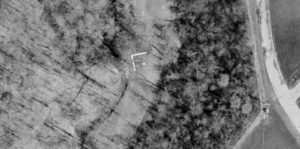
Tyvek Panels Marking Great Lot Monument
West from the Great Lot 47 monument, the northern line of Lot 47 runs just north of the hill where the old Circus Lots were, now owned by the Unitarians. Continuing the rest of the one-mile leg of a typical Great Lot, the northern line of Great Lot 47 ends near the center of North Street, just the other side of the Auburn Memorial Hospital.

Great Lot 47’s NW Corner Monument on North Street
There is no monument in the middle of North Street that I know of, but there is a stone monument referencing the corner along the western sidewalk, just one lot north of my old friend Mildred’s house.
During the same week I marked the NE corner of Great Lot 47 I also marked the Auburn Unitarian circus lot Star Circle, the Cayuga Community College nature trail, and the site of the then-pending NASA center. And I marked one corner of my own city property and so located one small rectangle within a much older shape of earth carved out of an ancient landscape.
I live a about a quarter-mile from the Northwest corner of Great Lot 47, and in 2002 I enjoyed hosting two planning and mapping experts from Cayuga County’s Planning Department at my house. As we ate lunch, their professional GPS receiver sat in my backyard collecting waypoints over my lot’s Southeast corner, the same corner I’d flagged with the polyethylene fiber panels two years earlier. Lunch over and them on their way, I went back to parenting, writing, and teaching. After a few weeks my planning friends contacted me to say that after differentially correcting the readings with extremely accurate data from a nearby GPS base station, they reported my location on earth with sub-meter precision. In short, I really know where I am in mapped space. But more and more I am thinking this is not enough.
Confident knowledge of location is just a starting point. It is only one way to begin thinking about place, feeling good about it, and wondering and expressing and sharing questions about it with others. It is not complete knowledge all by itself, but it is a nice way to begin. So when I hang out in the North Street Cemetery, probe the very fine sandy soils and gaze at the different mosses that grow there, I know I am near some of the oldest soils and plants in my neighborhood. I can ponder the path of the surveyors who dragged a Gunter’s Chain through the woods not much more than a few hundred feet from where I walk.
Plant people and gardeners I know give plants plenty of thought. The mosses that grow in the North Street Cemetery are certainly very old, but even fewer of us ponder mosses. But unless you share Robin W. Kimmerer’s love and expertise with mosses you’ll have a tough time even noticing them. Go. Look. They are wonderful. Perhaps you’ll look for another remnant, something like the compass plant Aldo Leopold looked for each Summer in the apex of a mid-western graveyard, celebrated and commemorated in his essay “Prairie Birthday.” Mostly you find nice specimens of the rather typical graveyard spruces, the “usual spruces” as Leopold called them. But, when you think about it, most of the trees seem to be pretty good size.
You can’t miss the big Red oak however; it is our county champion, and it may have been a younger tree in the 1700s, but it was certainly here.

Big Red oak in Auburn’s North Street Cemetery with Jet for scale.
I counted 188 rings of a much smaller Red oak toppled in Auburn’s Casey Park during the Labor Day storm of 1998. And while the North Street oak is not the largest Red oak in New York State, it is the largest we’ve found in Cayuga County.
This was Auburn’s first graveyard, and the deep roots that began here have supported the community and the neighborhood ever since. Just south of here, not one block from my house is the complete, Tiffany-styled Willard Memorial Chapel part of what was at the time, the center of Presbyterian North America. Thus my little corner of Lot 47 of the New Military Tract was the Western anchor of the steadfast, conservative Christian world as the dynamism of Christian revivalism unfolded in the 19th century, in what became the “Burned Over District” of the Finger Lakes.
Auburn was an important place in the 19th century American landscape. National figures of freedom and abolition like Harriet Tubman and William Seward made their homes here, and early leaders in women’s rights like Margaret Coffin Wright lived in Auburn. In March, the community commemorated the 100th anniversary of Harriet Tubman’s death, and the Harriet Tubman Home, the AME Zion Church, the NAACP, and aaduna all hosted numerous activities to remember her impact on the American story and identity.
Before the Great Depression, Auburn’s fortunes looked good, and inventors like Theodore Willard Case and his talking film technology took root. But the Great Depression hit Auburn hard. The rich departed. Major industries like Columbia Rope and International Harvester started to fall. Street names in my neighborhood – Perrine, Seminary, Seymour, and Nelson – reach to our deep roots in religious mission and the spirit of capitalism.
When we’ve planted trees in our neighborhood over the years, some of my friends remember playing ball on the spacious Seminary grounds and cutting through the entire block the Seminary occupied. Like all the old neighborhoods of Auburn, the streets were dense with trees, every walk a hike in a tunnel of elms. The elm in my backyard was so big that all the kids in the family could not join hands around it. You can’t see most of my house on the 1963 air photo since it is so deeply obscured by elm foliage.
In strictly rational terms, our urban forest is where we consider the combined condition, costs, and benefits of all our woody vegetation. But on a more emotional level, the urban forest is made up of all the green spaces around us that give us experiences of quiet, feelings of comfort, and a sense of place. If we take time to look over old family photos; if we take a minute and look over colorized photo post cards from the early 20th century; and if we can examine air photos to compare our current streets with days past, people will know what the “urban forest” is all about. Especially when you ask, “remember our elms?”

Seminary in 1904 ———- | ———- in 1938 ———- | ———-in 2003
When people in Auburn use these kinds of images to tap into their shared memories of the community’s elms, then they understand on an emotional level what we mean by the urban forest. This is important to note since the sadness associated with the loss of our elms – and Auburn was famous throughout the Finger Lakes for its elms – is sometimes a major emotional impediment to constructive action in addressing the severity of our urban forest decline. The elms were a source of stability and comfort and the loss of our elms to the Dutch Elm Disease happened to coincide with Auburn’s participation in Urban Renewal. The hit our forest took to the disease and demolition deeply wounded our community, and the loss we felt has never really gone away.

Downtown Auburn before and after urban renewal.
Before pic looking North | After pic looking South, with City Hall Roof highlighted in red for reference. Images courtesy of Bill Hecht, freepages.genealogy.rootsweb.ancestry.com/~springport/
The West Line of Great Lot 47 runs from the Hospital area south through downtown Auburn, near Colonel John Hardenbergh’s original mill site on the Owasco River, right next to the current Auburn Police and Fire Stations. Hardenbergh participated in the Sullivan Campaign of 1779, in which American soldiers marched from Pennsylvania into the Finger Lakes to subdue Cayuga and Seneca Indians. Just south and up the hill to Genesee Street and North Street turns into South Street and as you continue south you enter Auburn’s primier historic preservation district.
Sadly, over-zealous utility companies have ravaged Auburn’s street trees this winter, and some of the worst damage is along South Street, adjacent to William Seward’s Auburn home. The Seward House is one of our most important treasures, and it is too bad our public utilities are unwilling to take on a proactive, long-term urban forestry vision for our future.
Is it because at some level we’ve accepted that Auburn is rusting? Have we been co-opted by a village view of a City environment? It is true we are losing our people faster than ever. We are still losing our trees, and now we are losing our water supply lines and our roads. Residents have been moving to the suburbs for years, and like many old cities in the rust belt, the young keep leaving. State and federal revenue sharing has evaporated. Local tax revenue falls on fewer taxpayers. Aging, life-long residents who can’t run to the suburbs look for subsidized housing. And as just mentioned, power utilities – owned by off-shore interests – mow our trees with as little care as Amazonian loggers high-grade the rainforest.
But the economic and ideological forces that drive these demographic changes have not quenched the strong community spirit that animates small cities like Auburn. The South Street corridor is loaded with community leadership: the YMCA on William Street (just west of the Seward House), the Cayuga County Chamber of Commerce, and the Booker T. Washington Community Center on Chapman Avenue.
At the corner South Street makes with Elizabeth Street and Chedell Place you’ll reach the SW corner of Great Lot 47.
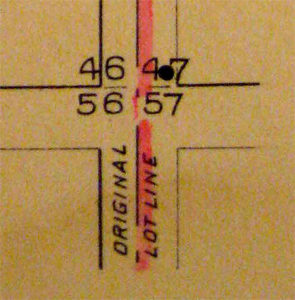
SW corner of Great Lot 47.
There’s no monument marking the Great Lot corner that I can find. Only about 3,200 feet east of this corner – down Elizabeth Street and over the bank – you would plow right into the Owasco River. There would be no problem to have primary contact with Owasco River water, since at this point you are just downstream of Owasco Lake, the primary drinking water supply for the majority of Cayuga County residents. If you go over the Lake Ave. bridge then take a right on Owasco Street and head south for a short bit until you reach Havens Avenue, you are close to the SE corner of Great Lot 47.

Southeast Corner of Great Lot 47.
Keep heading east from the intersection of South Seward and Havens, turn south at the stop sign and you’ll reach Dickman Farms, a wonderful nursery and garden center full of great plants and plenty of tree and plant people! If you went back to the other side of the Lake Ave. bridge, you could walk or drive 1,600 feet west and north to find the footbridge over the Mill Street dam. It is a lovely neighborhood, as shown below in one of Bill Hecht’s beautiful air photos:
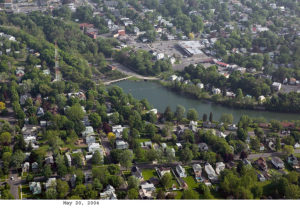
Mill Street along the Owasco River.
Inspecting this photo you may wonder why so many tree and plant people are concerned about the condition of Auburn’s urban Forest. The fact is that we are removing more trees than we are planting, and the city’s power company, NYSEG – owned by the Spanish company Iberdrola – has no interest in seriously working with city departments, taxpayers, and residents. Add the imminent Emerald ash borer invasion to this mis-management mode and you have the makings of the worst forest crisis in Auburn since urban renewal and the Dutch elm disease.
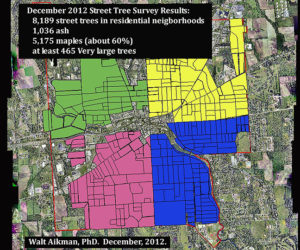
Sample results of Street Tree survey.
But the loss of our ash trees is not the only state-wide environmental threat we face. Regionally, everyone in the Finger Lakes also faces the onslaught of hydro fracking – deep drilling for natural gas. This drilling method threatens biodiversity, drinking water supplies, and the safety and harmony of our towns, villages, and small cities.
Strange as it may seem, Auburn is in the midnight seat of this controversy since the Auburn City Council is determined to bring huge quantities of hydro-fracked gas drilling wastewater for treatment at Auburn’s water pollution control plant. A local environmental action effort called the Cayuga Anti-Fracking Alliance is working hard to educate regional residents about this threat to the Owasco River and our community, and persuade the Auburn City Council to not bring these toxic wastes to Auburn. It is sad to realize the local efforts to bring these toxins to Auburn reflect the leadership dynamics permeating American society: unbridled greed, the resulting creative infertility, and a contempt for democracy.
If a strong sense of place grounded in local knowledge is one means of standing by the cycles of life, then I feel strongly that I have to act on my own navigational metaphor. In future posts, I’ll try to share the directional choices I make and so come clean on my own claims to investigating interesting places and local knowledge. These days it just isn’t enough to share stories about people and land. It doesn’t seem to matter enough to love wildlife, plants, and maps. In short, I need to begin with where I am, where I ground my ideas and perspective. I think this is more than my present “Location in Mapped Space,” it is where we keep and focus our hearts.
